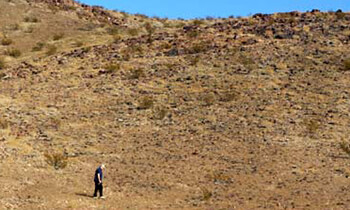Joshua Tree National Park
History, Geology and Description
Overview - Description - Things To Do - Maps - Where to Stay - Nearby - Videos

Since Joshua Tree National Park comprises parts of both the Mojave and the Sonoran Deserts, it features a startling diversity of life. Animals such as the coyote, yucca night lizard, burrowing owl, kangaroo rat, tarantula, and roadrunner live here; and plants vary from the ephemeral desert wildflowers to the cholla cactus, barrel cactus, and of course the Joshua tree. The park is immense and infinitely variable, yet delicately fragile. It is a land shaped by sudden torrents of rain and climatic extremes. Rainfall is sparse and unpredictable. Stream beds are usually dry, and water holes are few.
Cultural History
Native Cultures
In more verdant times, one of the Southwest's earliest
inhabitants, Pinto Man, lived here, hunting and gathering along a slow moving
river that ran through the now dry Pinto Basin. Later, the Serrano, Cahuilla
and Chemehuevi traveled through this area in tune with harvests of pinyon nuts,
mesquite beans, acorns and cactus fruit, leaving behind rock  paintings
and pottery ollas (pots with short wide necks and wide bellies) as reminders of their passing.
paintings
and pottery ollas (pots with short wide necks and wide bellies) as reminders of their passing.
Exploration & Settlement
In the late 1800s, explorers, cattlemen, and miners came to the desert. They built dams to create water tanks and dug up and tunneled the earth in search of gold. They are gone now but have left behind their remnants, the Lost Horse and Desert Queen Mines and the Desert Queen Ranch. In the 1930s, homesteaders came seeking free land and the chance to start new lives. Today many people come to the park's open space seeking clear skies and clean air, and the peace and tranquility, the quietude and beauty, that only the desert can provide.
Park History
- Proclaimed National Monument: Aug. 10, 1936.
- Wilderness Designation: Oct. 20, 1976.
- Designated a Biosphere Reserve: 1984.
- Designated a National Park: Signed into law October 31, 1994, the Desert Protection Act added 234,000 acres to Joshua Tree National Monument and promoted it to National Park status.
Natural History
Plants & Animals
The life force is patient here at Joshua Tree. Desert vegetation, oftentimes appearing to have succumbed to a sometimes harsh and unforgiving environment, lies dormant, anxiously awaiting the rainfall and moderate weather that will trigger its growth. Indian paintbrush, ocotillo, Mojave yucca, calico cactus, desert mallow, lupine, beavertail, prickly pear and many more unique desert species will suddenly explode with flowers in spring, painting the park in a profusion of colors.
![]() At the edges of daylight and under clear night stars, there is a fascinating multitude of generally unfamiliar desert wildlife. They include the coyote, yucca night lizard, burrowing owl, kangaroo rat, tarantula, roadrunner, desert iguana, jackrabbit and bobcat. Waiting out daytime heat, these creatures run, hop, crawl and burrow in the slow rhythm of desert life. Under bright sun and blue sky, bighorn sheep and golden eagles add an air of unconcerned majesty to this land.
At the edges of daylight and under clear night stars, there is a fascinating multitude of generally unfamiliar desert wildlife. They include the coyote, yucca night lizard, burrowing owl, kangaroo rat, tarantula, roadrunner, desert iguana, jackrabbit and bobcat. Waiting out daytime heat, these creatures run, hop, crawl and burrow in the slow rhythm of desert life. Under bright sun and blue sky, bighorn sheep and golden eagles add an air of unconcerned majesty to this land.
Geology
Joshua Tree National Park encompasses some of the most interesting geologic displays found in California's deserts. Rugged mountains of twisted rock and exposed granite monoliths testify to the tremendous earth forces that shaped and formed this land. Arroyos, playas, alluvial fans, bajadas, pediments, desert varnish, granites, aplite and gneiss interact to form a giant desert mosaic of immense beauty and complexity.

The Hexie Mountains, running northwest to southeast through the center of the park, help create the transition zone between two ecological zones: the Mojave Desert and the Colorado Desert, a subdivision of the Sonoran Desert. The Mojave, in the northwestern portion of the park, is a high desert with more rain and harsher winters. The Joshua tree is one of its most distinguishing features. It is the only place on earth where great stands of the Joshua tree (actually a giant yucca) grow wild.
![]() The Sonoran Desert is generally lower in elevation and much hotter than the Mojave. It is characterized by abundant creosote bushes, as well as small stands of spidery ocotillo and jumping cholla cactus. The Sonoran Desert extends east through Arizona and south into Baja and central Mexico.
The Sonoran Desert is generally lower in elevation and much hotter than the Mojave. It is characterized by abundant creosote bushes, as well as small stands of spidery ocotillo and jumping cholla cactus. The Sonoran Desert extends east through Arizona and south into Baja and central Mexico.
A third ecological zone is represented by five fan palm oases scattered throughout the park. These verdant ecosystems provide a startling contrast to their arid surroundings. Here, due to geologic faults, water occurs naturally at or near the surface, meeting the special life requirements of these stately palm trees, in addition to the abundance of other wildlife they support.
Overview - Description - Things To Do - Maps - Where to Stay - Nearby - Videos
Joshua Tree National Park
74485 National Park Drive
Twentynine Palms, CA 92277
760-367-5500
Watch Video on the Rocks in The Park
Share this page on Facebook:
The Desert Environment
The North American Deserts
Desert Geological Terms








